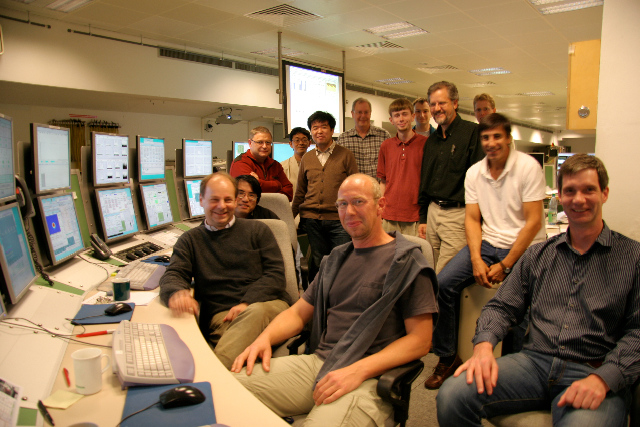Director's Corner
23 April 2009
 Barry Barish |
FLASH – ILC-like beam tests at DESY
Developing high-gradient superconducting radiofrequency (rf) cavities, cryomodules and rf systems for the ILC is at the heart of our R&D programme. An essential part of this programme will be systems tests, including tests with beams. Before we can develop our own test systems that use ILC modules, we are making a series of important tests using the FLASH free-electron laser linac at DESY. These tests are enabling us to have an early look at a variety of questions by using an electron linac operating near our reference design gradients and with nominal ILC-like beams.
The FLASH linac uses 48 superconducting rf cavities housed in six cryomodules and powered from three high-power klystrons. The final three cryomodules are powered from a single 10 Megawatt multi-beam klystron, similar to the ILC reference design rf unit. We have several important goals for our experiments using FLASH: to demonstrate bunch-to-bunch beam energy uniformity and pulse-to-pulse beam energy stability with long pulses at full beam loading, to characterise issues which limit operation at high gradients, to quantify the klystron rf power overhead required for low level radiofrequency (LLRF) control and to measure cryogenic loads. Reaching these goals presents some challenges for FLASH, as it requires running near the operational limits.
The "9mA Experiment" required several improvements to FLASH, in particular the LLRF system performance, functionality, and robustness. FLASH is a shared facility and our ILC tests are being coordinated by Nick Walker (DESY) and John Carwardine (Argonne), and so far they have had three short test periods last autumn and are planning for a major test run next September. A big challenge for these tests is to run as near as possible to ILC operating conditions as noted in the table. In the second run performed last September, they reached an important milestone by operating FLASH with 3-nanocoulomb bunches and a one-Megahertz repetition rate for pulse lengths up to 550 microseconds before the run was prematurely terminated by a vacuum incident. The run in January focused on characterising the dump line optics and beam apertures, increasing LLRF regulation gain, testing LLRF feed-forward algorithms, and assessing gradient limits.
Preparations are now underway for a dedicated machine run in the autumn of 2009, when the goal will be to achieve the full 9mA with an 800-microsecond pulse length, while operating the cavities close to their gradient limits. The team will have five consecutive weeks of machine time starting in August and ending immediately prior to a major FLASH shutdown and upgrade. The commitment of five consecutive weeks of machine time shows the significance and priority that DESY places on these tests. Following a three-week access period to repair the beam dump vacuum line and to commission new diagnostics and low-level rf hardware, the 9mA team will have two weeks of dedicated around-the-clock beam studies to reach their goals.
Low-level rf systems are an important focus of the 9mA programme because of their role in regulating beam energy and in rapidly detecting cavity quenches and are being worked up by an international collaboration, comprising DESY LLRF experts together with colleagues from KEK, Fermilab, and SLAC.
Planning for the August/September run has included a
mini-workshop held at DESY on 16 January. It is crucial that we are well prepared, because this will be the last opportunity for beam time before the end of Technical Design Phase-1.
Cryomodule string tests are another essential element in preparing to propose a robust ILC project for construction. We will carry out such tests using ILC cavities and cryomodules in the future in projects both at KEK and Fermilab. The first of these will be our so-called S1-global project at STF (Superconducting RF Test Facility) at KEK. This project is global in the sense that the cavities and cryomodules are being contributed from the international collaborators and this will make it a realistic test of the plug-compatibility concept. S1-global will be a cavity-string performance test using our own modules and this will be followed by more ambitious system tests at both KEK and at Fermilab's ILCTA-NML (ILC Test Area in the New Muon Lab). The time scales for these tests are such that our primary goal of demonstrating the beam phase and energy stability at nominal current, including testing of beam based feedback systems, will be performed in the FLASH studies described above.
-- Barry Barish


